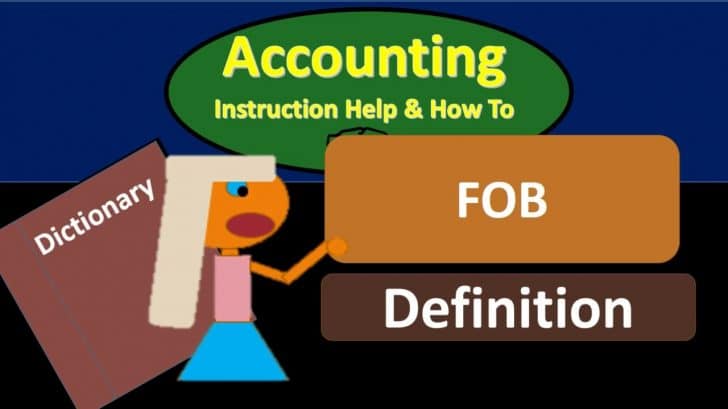Basically, the buyer takes complete control over the delivery once a freight carrier picks the goods. Under this arrangement, the buyer assumes the risk at the point of origin. Despite the seller covering shipping costs, the ultimate responsibility and risk for the products rests with the buyer. FOB shipping point puts the buyer in the driver’s seat once goods are loaded at the origin port or shipment point. With the FOB shipping point option, buyers have increased control over the transportation process. Clearly defining the FOB shipping point in the sales contract removes ambiguity about when ownership and risk transfer.
Other FOB Terms
CIP stands for “carriage and insurance paid to” says that the seller pays for delivery and insurance of goods to a carrier or nominated location. FOB, or “free on board,” is a widely recognized shipping rule created by the International Chamber of Commerce (ICC). It defines the point when a buyer or seller becomes liable for goods transported by sea. For example, assume Company XYZ in the United States buys computers from a supplier in China and signs a FOB destination agreement. Assume the computers were never delivered to Company XYZ’s destination, for whatever reason.
FOB destination, freight collect and allowed
Even though the buyer pays for shipping costs, the seller retains ownership of the goods during transit. The seller remains responsible for the goods until they reach the destination. You’ll learn how FOB shipping point impacts ownership and risk transfer, divide costs between buyers and sellers, and affect your accounting practices. Read all contracts carefully, calculate potential costs, purchase insurance—and consider negotiating additional terms in your shipping or sales agreement to protect against losses. The buyer is not responsible for the goods during transit; therefore, the buyer often is not responsible for paying for shipping costs.
What is an example of FOB shipping point?
That destination is the receiving port, not the final stop or seller’s warehouse in the journey across the country. The buyer assumes fees like customs clearance fees and taxes Navigating Financial Growth: Leveraging Bookkeeping and Accounting Services for Startups at port entry. Freight-in refers to the shipping costs for which the buyer is responsible when receiving shipment from a seller, such as delivery and insurance expenses.
https://thearizonadigest.com/navigating-financial-growth-leveraging-bookkeeping-and-accounting-services-for-startups/ located at 6615 Grand Ave, Gurnee IL is the go-to resource for packing, shipping, printing and business service needs of the residents and businesses of Gurnee, IL. The owner Jim LoMonaco is a part of every day operations as well as a resident of Gurnee. Merchandise Inventory increases (debit), and Cash decreases (credit), for the entire cost of the purchase, including shipping, insurance, and taxes. On the balance sheet, the shipping charges would remain a part of inventory. Be explicit in your communications, especially regarding freight charges and when ownership passes between buyer and seller. Whether you’re the buyer or the seller, neglecting insurance can leave you exposed to risks during international trade, especially when shipping via a freight forwarder.
Notary Public/Notary Service
- FOB terms influence when buyers and sellers pass FOB shipping point journal entries and record transactions in their ledgers, impacting financial reporting and inventory management.
- If FOB shipping point is listed on the purchase contract, this means the buyer pays the shipping charges (freight-in).
- Assume the computers were never delivered to Company XYZ’s destination, for whatever reason.
- Shipping costs are usually tied to FOB status, with shipping paid for by whichever party is responsible for transit.
- When the risk of loss shifts from the seller to the buyer and determining who foots the bill for freight and insurance, all depend on the nature of the contract.
FOB, which stands for Free On Board, is a vital delivery term published by the International Chamber of Commerce (ICC). The term designates when responsibility transfers from seller to buyer during transit. For example, in FOB https://thetennesseedigest.com/navigating-financial-growth-leveraging-bookkeeping-and-accounting-services-for-startups/, the buyer is responsible for freight, insurance, and other costs from the shipping point onward. Especially for international ecommerce, a freight forwarder can help manage logistics, reducing the complexity and risk for the buyer in a FOB shipping point agreement. If you’re ordering many products from a single seller, you may have more leverage to negotiate FOB destination terms, as the cost of shipping per unit will likely be lower for the seller.
Shipping Done Right: FOB Shipping Point vs FOB Destination
- When using the FOB shipping point, it’s essential to understand who is responsible for the shipping costs.
- Having special contracts in place has been important because international trade can be complicated and because trade laws differ between countries.
- This means that the shipping costs stay with the inventory until it is sold.
- Now choose your customizing request number and save the shipping point configuration data.
- Before setting sail with the FOB shipping point, remember a few considerations.
Shipping terms affect the buyer’s inventory cost because inventory costs include all costs to prepare the inventory for sale. Merchandise Inventory increases (debit) and Accounts Payable increases (credit) by the amount of the purchase, including all shipping, insurance, taxes, and fees [(40 × $60) + (40 × $5)]. Delivery Expense increases (debit) and Cash decreases (credit) for the shipping cost amount of $100. On the income statement, this $100 delivery expense will be grouped with Selling and Administrative expenses. Under the FOB shipping point, the buyer can record an increase in their inventory as soon as the products are placed on the ship.
How do I follow-up with my shipment once it has been tendered to Best 4 Shipping?
Free on board is one of around a dozen Incoterms, or international commercial terms. Incoterms are published and maintained by the International Chamber of Commerce (ICC).

